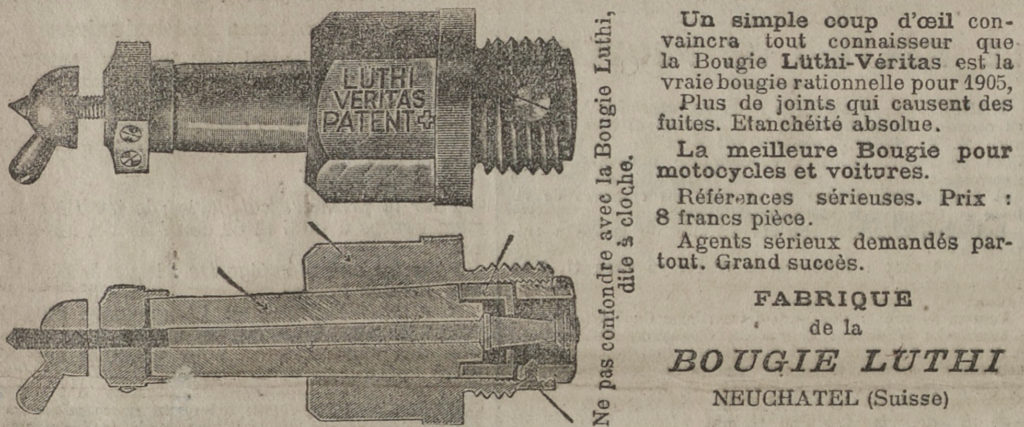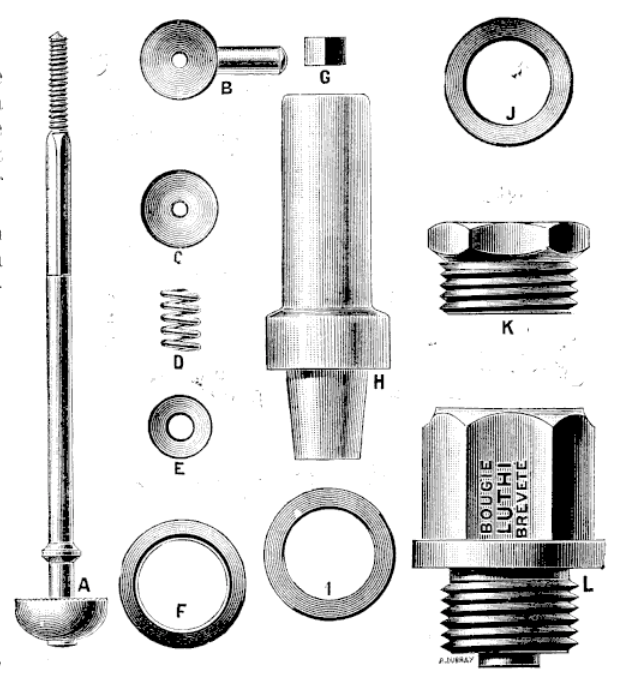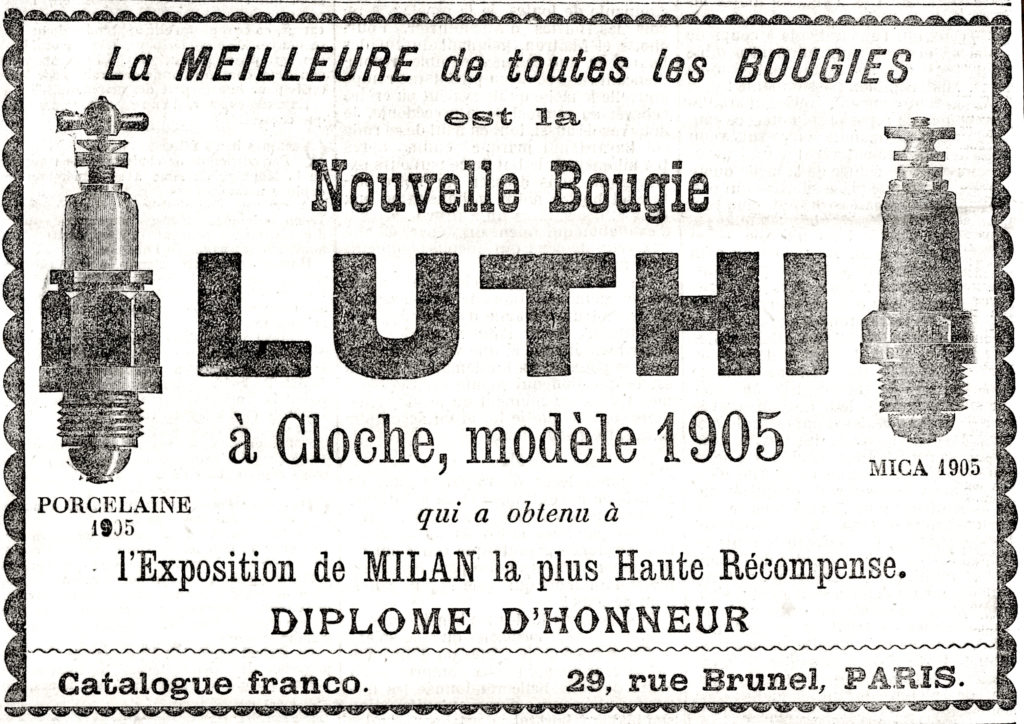
Index
This article has been originally published in « Ignitor », SPCOA – Spark Plug Collectors of America, New York, USA – Spring 2020 – Volume 45 #2
This article on Luthi spark plugs contains two parts. In part 1 I will discuss the history of the Luthi spark plugs taking into consideration both, the French made “Bougie Luthi Veritas” and the Swiss made “Lüthi Libertas”. Both are interrelated and their history is intertwined. The reason why the name of the spark plug is written in two different ways is quite simple: “Luthi” without the two dots on the letter u is the French spelling of the German name “Lüthi”. Since most of the spark plugs were sold in France, the French omitted the dots on the u, as they are not necessary in their language. In part 2 you will find an identification chart that will help you establish the production year of your French made “Bougie Luthi Veritas” or your Swiss made “ Lüthi Libertas” spark plugs.
I would like to thank the following spark plug collectors for their help as well as pictures and documentations that they have sent me, their help has been crucial for my research work: Frank Schulze, Fred Arger, Bruno Stadelmann, Kees Koster, Stephan and Otto Berz, Martien Zanden and the French historian Didier Mahistre.
Part 1 – The history of the Luthi spark plug
The origin of the Luthi spark plug
The Luthi spark plug gets its name from Hermann Luthi, a Swiss cutler who on January 10, 1901 established together with Ernst Zürcher the “Zürcher, Lüthi & Cie” company in St. Aubin, on the shores of lake Neuchâtel in Switzerland. Soon thereafter they registered their world-famous trademark for engines, cars and motorcycles “Zedel”, it is a composition of the first letters of the two founders, “Zed” for Zürcher and “El” for Lüthi. Ernst Zürcher was the mechanical genius and Hermann Lüthi the businessman.
The reason why Hermann Lüthi left the very successful company in April, 1902, little over a year after having founded it, is not entirely clear. During his involvement with Zedel he met Rudolf Egg, a brilliant engineer from Zurich who had produced the very first motor car in Switzerland in 1896 and would invent in 1902 the French built “Bougie Luthi” spark plug. Surprisingly all three men were born in 1865 and must have shared the same sense of competition, innovation and entrepreneurship that was about to completely revolutionize the industry of personal mobility.
The French made “Bougie Luthi” also known as “Veritable Bougie Luthi” and “Luthi Veritas”
As mentioned earlier, Rudolf Egg was the inventor of the very successful spark plug with the bell-shaped electrode. But why is the brand name of this spark plug “Luthi” and not “Egg”?
Let us start with the very first Luthi spark plug (see part 2 – -Bougie Luthi type 1a) that was an instant success when the first high voltage magneto ignition systems appeared, since the nickel electrodes of this new type of spark plugs could withstand the higher temperatures and would therefore not melt.
This spark plug was invented by Rudolf Egg. He sold his invention to Hermann Lüthi who in turn granted a license to produce and sell this spark plug to a French company in Paris. I would think that the first “Bougie Luthi” must have been quite a good spark plug, judging from the ads published by the company in the leading French newspapers bragging about the fact that the motorcycles and cars that won certain famous races in France were equipped with Luthi spark plugs. But maybe not good enough for prolonged use, because Rudolf Egg soon further developed the initial concept and patented on Christmas day in 1902 the “Bougie Luthi” with a bell-shaped electrode in France and sold the license to produce this type of plug to the same Paris based factory that produced the first Luthi spark plug.
During the “Salon de l’Automobile” in France of Christmas 1903 “Bougie Luthi” advertisements announced that they had already sold 120’000 spark plugs – 8 years later the sales figures amounted to 1’500’000. The “Bougie Luthi” was very successful, even the Paris Police Department and the French Navy equipped their vehicles exclusively with this type of spark plug. The success story of this spark plug must have been very impressive in those days. Apart from the many testimonials by racing drivers, famous people and known automobilists who confirmed the high quality of this bell-shaped spark plug, a multitude of automobile , motorcycle and boat races were won by vehicles equipped with “Bougie Luthi” spark plugs; often the “Bougie Luthi” would win “Medals of Honour” in famous European exhibitions, for example in Milan in 1905 and Turin in 1907. Still, the success and fame were not limited to France, the bell-shaped “Bougie Luthi” was exported to most European countries, the USA and Australia. This very illustrious spark plug was sold in a wooden box sealed with a ribbon mentioning the name “Bougie Luthi”
The French “Bougie Luthi” company was very active and creative in marketing as well as in the development of the spark plug design and technical components thereof. As described in part 2, the “Bougie Luthi” underwent a steady development from 1902 to 1907, making it quite easy to determine the production year of every French made bell-shaped Luthi spark plug. Another interesting and well-known marketing principle used by the company is “Win on Sunday and sell on Monday”. I have found innumerable newspaper ads by the “Bougie Luthi” company with references to races, stating that the winning vehicle was equipped with “Bougie Luthi” spark plugs.
However great the race victories were, sometime around 1908 the production of the French made “Bougie Luthi” bell shaped spark plugs stopped, the factory ceased its production and the remaining spark plug stock was sold to a dealer located in the outskirts of Paris. The last ad for “Bougie Luthi” I could find is from 1909. Why the production stopped is unclear, I can only presume that the design could not be further developed to meet the requirements of the new engines with higher compression ratios.
Unfortunately, I have so far been unable to find a copy of the magnificent 16-page catalogue of the “Bougie Luthi” that is mentioned so often in the French ads. If you have one of these catalogues or know somebody who does, please contact me hermann@zedel.com).
The Swiss made Lüthi Libertas, also known as Presta and Edco spark plugs made by Edouard Dubied & Co. Couvet
As mentioned in the previous chapter, the second “Bougie Luthi” patent for the famous bell-shaped spark plug was not in the name of Hermann Luthi, but in the name of its inventor Rudolf Egg. Somehow Hermann Lüthi was outmaneuvered by the inventor and the manager of the Paris spark plug factory. While the new bell-shaped spark plugs sold like hotcakes, the old and first Luthi spark plug sales declined and came to a standstill sometime in 1903.
But Hermann Lüthi was not the guy to concede defeat that easily. In fact, he obtained another patent for a spark plug that was more modern than the bell-shaped Paris based “Bougie Luthi”. With the compression ratios of the engines increasing considerably every year, the older type bell-shaped spark plugs had solved the electrode problem, but not the sealing problem. Lüthi’s new spark plug had a conical isolator sitting in a conical shell housing counterpart. The engine compression pushes the isolator on to the shell-housing which is also conical and seals off the spark plug almost completely. Whereas the older bell-shaped “Bougie Luthi” had a more cylindrical isolator in a cylindrical shell housing. After longer exposure to engine compression, the two parts would have play and not seal off the spark plug, therefore causing loss of compression and engine malfunction.
This time Luthi found a strong and internationally active Swiss industrial company for the production of his new and much more modern spark plug. The headquarters of the Edouard Dubied & Co. company are located in a remote Valley in the Swiss Jura mountains known for its watch making industry and craftmanship. E. Dubied & Co. had successfully started producing parts for the budding automotive industry under two brand names: Presta and Edco. In order to avoid heavy custom taxes and export regulations, they had established additional factories in France and Germany.
Swiss made “Bougie Luthi” changes its name to Lüthi Libertas, Presta and Edco
At this point the story of both spark plugs, built by different companies but carrying the same name, gets a little complicated.
The new spark plug made by the Swiss company Edouard Dubied & Co was originally sold in 1905 under the same brand name as the spark plug sold by the French Bougie Luthi company: Luthi Veritas. After legal disputes the Swiss company dropped the “Luthi Veritas” and “Bougie Luthi” brand names and changed it to “Lüthi Libertas”, whereas the French Bougie Luthi company registered the brand names “Luthi Veritas” and “Veritable Bougie Luthi”.
“STOP IT ! or else….”



Part 2- identification guide
Bougie Luthi – type 1a 1902 - 1903
Patents: FR323549 August 7, 1902 (for France) / CH26969 August 19, 1902 (for Switzerland) both patents are in the name of Hermann Luthi, Neuchâtel, Switzerland
This spark plug was only produced for a very short period in France. Probably between Fall 1902 and Spring 1903.
Inventor: Rudolf Egg, Zurich, Switzerland
Distinguishing features
The letters in the list do not coincide with the technical drawing
a) Terminal nut: top and lower nut are round and knurled
b) Spring: small spiral spring
c) Insulator: cylindrical with asbestos washers
d) Hexagon: takes up the entire metal shell
e) Markings: no visible marking
f) Thread: takes up half of the metal shell nose
g) Bell: no bell, instead “The ground electrode is replaced by the separating wall of the gas chamber “D”. The spark jumps from the center electrode to the rim of the hole through which the center electrode passes. The burnt gases stay in the small chamber and prevent the porcelain from becoming black.”

Oldest known Luthi spark plug ad : L’Auto-Velo November 26, 1902

Win on Sunday – sell on Monday.
An ad from December 1902 (L’Auto-Velo) announcing the world record obtained by Lamberjack thanks to the “Bougie Luthi” and also stating “Isn’t that a noteworthy debut (of the Bougie Luthi) »

Bougie Luthi type 1b 1904
English patent no. GB190405824 from March 9, 1904 and French patent no. FR323549 3041 from March 18, 1904
Inventor: unknown
Not much is known about the type 1b Luthi spark plug. The French patent however reveals the intentions of the inventor. Type 1a and 1b have both the same patent number, but type 1b has an extension number “3041” meaning that it is a development of type 1a.
I have never found any ad nor picture of the type 1b.

La Bougie Luthi - type 2a 1903
Patents: FR327684 December 24, 1902 (for France) in the name of Rudolf Egg
The model 1903 spark plug was produced during 1903.
Inventor: Rudolf Egg
No mica version for the 1903 model, only porcelain
Distinguishing features
a) Terminal nut: two round and knurled terminal nuts.
b) Spring: long spiral spring
c) Insulator: cylindrical and with asbestos washers, top end with rounded edges
d) Hexagon: takes up almost the entire metal shell.
e) Markings: no visible marking
f) Thread: does not take up the whole metal shell nose space
g) Bell: rim is even, it does not have any teeth


La Bougie Luthi - type 2b 1903 - 1905
First mention of a mica version of this spark plug is in an ad from L’Auto on 19.09.1904 although without picture or drawing of it.
The model 1904 was produced from fall 1903 to winter 1905
Distinguishing features
(these following letters do not correspond to the letters in the drawing)
a) Terminal nut: with one lever
b) Spring: small spiral spring
c) Insulator: cylindrical and with asbestos washers, top end with flat edges
d) Hexagon: big hexagon with small lower cylindrical ending
e) Markings: BOUGIE LUTHI BREVETE on hexagon
f) Thread: takes almost all the space of the metal shell nose
g) Bell: edge of the bell shaped electrode with small teeth

Exploded view of the “Bougie Luthi” from the sales brochure.


La nouvelle bougie Luthi - type 2c 1905
The model 1905 was produced from Spring 1905 to Winter 1906.
Distinguishing features
Porcelain
a) Terminal nut: with two levers, lower nut with round base and conical top ending
b) Spring: small spiral spring
c) Insulator: cylindrical and with asbestos washers, top end with rounded edges
d) Hexagon: big hexagon with small lower cylindrical lower ending
e) Markings on hexagon: LUTHI Pantent +, Breveté SGDG, Patented, D.R.P., Brevettato
f) Thread: takes up almost all the space of the metal shell nose
g) Bell: edge of the bell-shaped electrode with small teeth
Mica
a) Terminal nut: round knurled upper “double” nut, lower cylindrical and hexagon nut
b) Spring: no spring
c) Insulator: conical with flat edges on top end
d) Hexagon: small hexagon with even smaller lower cylindrical lower ending
e) Markings: “LUTHI”, BteG.D.G.
f) Thread: takes up all the metal shell nose
g) Bell: edge of the bell-shaped electrode with small teeth – all in all wider bell

The Paris based “bougie Luthi” company was quite creative with its model year denominations. Often different types of spark plugs would have the same year model designation. This is due to the fact that the ads would always publicize the newest type. The same spark plug would be announced as 1904 model in that year and in the January ads of the following year as the 1905 type. This happened also for other year model denominations.

Bougie Luthi - type 2d 1906
The model 1906 was produced from Winter to Fall 1906.
Distinguishing features
Porcelain:
a) Terminal nut: with one lever
b) Spring: small spiral spring
c) Insulator: conical with asbestos washer, top end with rounded edges
d) Hexagon: takes up half the metal body shell with cylindrical lower ending
e) Markings: LUTHI VERITAS, D.R.P. (Germany), PATENTED (UK and USA), S.G.D.G. (France), BREVETTATO (Italy)
f) Thread: takes up almost all the space of the metal shell nose
g) Bell: edge of the bell shaped electrode with small teeth, less
Mica same as 1905 model


Above: In England the « Bougie Luthi » was sold and maybe built by Brown Brothers Ltd. in London under the name « Albo-Luthi ».

La nouvelle Bougie Luthi Veritas- type 2e 1907- 1908
Sold in a wooden box sealed with a ribbon mentioning “Bougie Luthi”
This is the last evolution of the “Bougie Luthi”. After this type there were no further developments made to the bell-shaped French made “Luthi Veritas” spark plug.
Porcelain:
a) Terminal nut: round knurled top nut, flat and conical hexagon lower nut
b) Spring: no spring
c) Insulator: cylindrical and with asbestos washers, top end with flat edges
d) Hexagon: hexagon takes up half the metal body shell with cylindrical lower ending
e) Markings: L.V. on insulator; LUTHI, S.G.D.G, VERITAS on hexagon and FRANCE & ETRANGER on cylindrical lower body shell
f) Thread: takes up the entire metal shell nose
g) Bell: edge of the bell shaped electrode with large teeth and small holes
Mica:
a) Terminal nut: round gnarled upper “double” nut, lower cylindrical and hexagon nut
b) Spring: no spring
c) Insulator: conical shape with flat edges on top end
d) Hexagon: small hexagon with even smaller lower cylindrical lower ending
e) Markings: LUTHI VERITAS on hexagon and FRANCE ETRANGER on lower cylindrical part of metal body shell
f) Thread: takes up all the metal shell nose
g) Bell: edge of the bell-shaped electrode with big teeth – same bell shape as porcelain, also with holes

the Paris based “Bougie Luthi” factory owner Mr. R. Lerède published ads in 1908 pretending that “Bougie Luthi” had been further developed that year, whereas in fact it was the same spark plug as in 1907.
Even though it says 1908 on the ad, it is the same plug as in 1907, since there was no further development of the Bougie Luthi from 1907 onwards.
The ads in „L’auto“ for the Bougie Luthi 1907 date from July 1907 to May 1909.

Lüthi Swiss made spark plug Type 3a 1905 - 1908
Patents: Swiss patent no. CH31234 from July, 30 1904
Inventor: unknown
Produced by the Swiss based company Edouard Dubied & Cie. and sold under the name „Lüthi Veritas“ from 1905 to 1907. After a legal dispute with the French „Bougie Luthi“ company, this spark plug was sold in France under the name of „Presta“.
The main distinguishing feature of this spark plug is
the recessed screw embedded in the thread on the spark plug nose and the cone shaped isolator.




Lüthi Libertas Type 3b 1907 – 1917
Swiss patent no. CH31234 from July, 30 1904 and French patent no. FR356525 from July, 29 1905
Inventor: unknown
This is the last chapter in the history of the Luthi spark plug. The patent for the Lüthi Libertas spark plug is in the name of Hermann Lüthi – unfortunately I have not been able to find the name of the inventor yet. I can only presume that Hermann Lüthi sold the licence to produce this more modern type of spark plug to the Edouard Dubied & Co.. This company produced the spark plugs in its factories in Germany and France in order to avoid heavy customs fees. In England the Lüthi Libertas where sold under the name EDCO and distributed and maybe even built by W. A. King, the brother in law of Mr. Dubied. In France and Italy the Lüthi Libertas was distributed under the name PRESTA.




